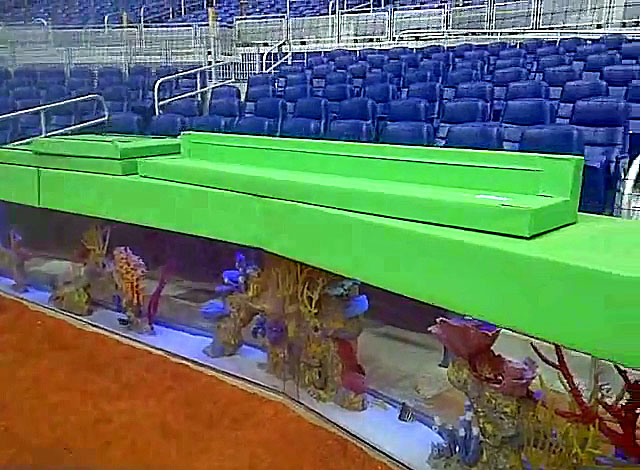Are Aquariums at the Marlins' New Ballpark Fish Abuse?

It's usually a bad idea to throw fastballs at a fish tank. Designers of the new Marlins baseball stadium in Miami have disregarded that maxim, and have installed two 20-foot-long tropical fish aquariums on the field directly behind home plate.
Marlins President David Samson says using aquariums as a backstop "screams Miami," but animal rights activists think it screams animal abuse. Experts on fish wellbeing are undecided on the matter.
First, despite their position in the line of fire, the stadium aquariums won't bust. According to Mat Roy, president of Living Color Aquariums, which manufactured the tanks, Marlins first baseman Gaby Sanchez helped test their extra-sturdy front panels by hurling baseballs at them. They didn't crack.
But even if the 100 fish inside the tanks are sure to stay wet, activists have another concern. "I can tell you even if the glass doesn't shatter, [stadium noise is] going to cause a tremendous vibration and disturb and upset the fish," Animal Rights Foundation of Florida spokesman Don Anthony told the local press.
To minimize vibrations from a stadium full of rowdy fans, the temperature-controlled aquariums are suspended on a flexible material called neoprene, but activists think that isn't sufficient. "No matter how many shock absorbers they build into the system, if there are thousands of fans screaming and jumping during a sporting event it's going to affect the fish in there," Anthony said.
So, will noise and stadium vibrations actually upset the fish?
Amrit Bart, professor of aquaculture and director of the Asian Institute of Technology in Vietnam, has studied the effects of vibrations and ambient noise on fish health and reproduction. "Our preliminary study showed that chronic exposure to low-frequency, high-amplitude sound may affect reproduction," Bart told Life's Little Mysteries.
Sign up for the Live Science daily newsletter now
Get the world’s most fascinating discoveries delivered straight to your inbox.
He added that fish can hear and do respond to airborne noise, but that sound and vibrations are significantly attenuated when they enter fish tanks. The only feasible way to detect subtle declines in fish health due to noise and vibrations is to compare their rates of reproduction in acoustically quieted commercial fish farms with reproductive rates in noisy fish farms. Research shows that fish reproduction does suffer in the latter case, but in a small-scale setup like the Marlin stadium tanks, Bart said there is too little data to form a professional opinion about the fish's wellbeing.
The only solid information available is this: Marlins Executive VP for Ballpark Development Claude Delorme recently set up a pitching machine to launch baseballs at the tank with fish inside, and observed their response. "You would see a small reaction — they would move because they would sense something in that area," Delorme said.
One might ask: Besides dying, what other way do fish have of expressing their discontent?
Follow Natalie Wolchover on Twitter @nattyover. Follow Life's Little Mysteries on Twitter @llmysteries, then join us on Facebook.
Natalie Wolchover was a staff writer for Live Science from 2010 to 2012 and is currently a senior physics writer and editor for Quanta Magazine. She holds a bachelor's degree in physics from Tufts University and has studied physics at the University of California, Berkeley. Along with the staff of Quanta, Wolchover won the 2022 Pulitzer Prize for explanatory writing for her work on the building of the James Webb Space Telescope. Her work has also appeared in the The Best American Science and Nature Writing and The Best Writing on Mathematics, Nature, The New Yorker and Popular Science. She was the 2016 winner of the Evert Clark/Seth Payne Award, an annual prize for young science journalists, as well as the winner of the 2017 Science Communication Award for the American Institute of Physics.










